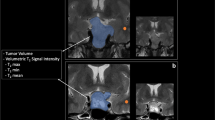Abstract
Rationale and objectives
Pituitary macroadenomas are predominantly benign intracranial neoplasms that can be locally aggressive with invasion of adjacent structures. Biomarkers of aggressive behavior have been identified in the pathology literature, including the proliferative marker MIB-1. In the radiology literature, diffusion weighted imaging and low ADC values provide similar markers of aggressive behavior in brain tumors. The purpose of this study was to determine if there is a correlation between ADC and MIB-1 in pituitary macroadenomas.
Materials and methods
A retrospective review of diffusion imaging and immunohistochemical characteristics of pituitary macroadenomas was performed. The ADC ratio and specimen Ki-67 (MIB-1) indices were measured. Linear regression analysis of normalized ADC values and MIB-1 indices was used to compare these parameters.
Results
There were 17 patients with available ADC maps and MIB-1 indices. Local invasion was confirmed by imaging and intraoperative visualization in 11 patients. The mean ADC ratio for the invasive group was 0.68, with a mean MIB-1 index of 2.21 %. In the noninvasive group, the mean ADC ratio was 1.05, with a mean MIB-1 index of 0.9 %. Linear regression analysis of normalized ADC values versus MIB-1 demonstrates a negative correlation, with a linear slope significantly different from zero (p = 0.003, correlation coefficient of 0.77, and r squared = 0.59).
Conclusion
We determine a strong correlation of low ADC values and MIB-1, demonstrating the potential of diffusion imaging as a possible biomarker for atypical, proliferative adenomas, which may ultimately affect the surgical approach and postoperative management.



Similar content being viewed by others
References
Asa SL, Ezzat S (1998) The cytogenesis and pathogenesis of pituitary adenomas. Endocr Rev 19:798–827
Ezzat S, Asa SL, Couldwell WT et al (2004) The prevalence of pituitary adenomas: a systemic review. Cancer 101:613–619
Magagna-Poveda A, Leske H, Schmid C et al (2013) Expression of somatostatin receptors, angiogenesis and proliferation markers in pituitary adenomas: an immunohistochemical study with diagnostic and therapeutic implications. Swiss Med Wkly 143:1–11
Ironside JW (2003) Pituitary gland pathology. J Clin Pathol 56:561–568
Asa SL (2008) Practical pituitary pathology: what does the pathologist need to know. Arch Pathol Lab Med 132:1231–1240
Zada G, Woodmanse WW, Ramkissoon S et al (2011) Atypical pituitary adenomas: incidence, clinical characteristics, and implications. J Neurosurg 114:336–344
Osamura RY, Kajiya H, Takei M et al (2008) Pathology of the human pituitary adenomas. Histochem Cell Biol 130:495–507
Saeger W, Ludecke DK, Buchfelder M et al (2007) Pathohistological classification of pituitary tumors: 10 years of experience with the German Pituitary Tumor Registry. Eur J Endocrinol 156:203–216
Mete O, Ezzat S, Asa SL (2012) Biomarkers of aggressive pituitary adenomas. J Mol Endocrinol 49:69–78
Paek KI, Kim SH, Song SH, Choi SW et al (2005) Clinical significance of Ki-67 labeling index in pituitary macroadenoma. J Korean Med Sci 20:489–494
Ginat DT, Mangla R, Yeaney G et al (2010) Correlation of diffusion and perfusion MRI with Ki-67 in high grade meningiomas. AJR 195:1391–1395
Calvar JA, Meli FJ, Romero C, Calcagno ML et al (2005) Characterization of brain tumors by MRS, DWI and Ki-67 labeling index. J Neurooncol 72:273–280
Matsuyama J (2012) Ki-67 expression for predicting progression of postoperative residual pituitary adenomas: correlations with clinical variables. Neurol Med Chir 52:563–569
Mohamed FF, Abouhashem S (2013) Diagnostic value of apparent diffusion coefficient (ADC) in assessment of pituitary macroadenoma consistency. Egypt J Radiol Nucl Med 44:617–624
Mahmoud OM, Tominaga A, Amatya VJ, Ohtaki M et al (2011) Role of PROPELLER diffusion weighted imaging and apparent diffusion coefficient in the evaluation of pituitary adenomas. Eur J Radiol 80:412–417
Sizuki C, Maeda M, Hori K et al (2007) Apparent diffusion coefficient of pituitary macroadenoma evaluated with line scan diffusion weighted imaging. J Neuroradiol 34:228–235
Boxerman JL, Rogg JM, Donahue JE, Machan JT et al (2010) Preoperative MRI evaluation of pituitary macroadenoma: imaging features predictive of successful trans-sphenoidal surgery. AJR 195:720–728
Pierallini A, Caramia F, Falcone C et al (2006) Pituitary macroadenomas: preoperative evaluation of consistency with diffusion weighted MR imaging- initial experience. Radiology 239:223–231
Micko ASG, Wohrer A, Wolfsberger S, Knosp E (2015) Invasion of the cavernous sinus space in pituitary adenomas: endoscopic verification and its correlation with MRI-based classification. JNS 122:803–811
Author information
Authors and Affiliations
Corresponding author
Ethics declarations
Conflict of interest
The authors of this manuscript have no conflicts of interest.
Rights and permissions
About this article
Cite this article
Tamrazi, B., Pekmezci, M., Aboian, M. et al. Apparent diffusion coefficient and pituitary macroadenomas: pre-operative assessment of tumor atypia. Pituitary 20, 195–200 (2017). https://doi.org/10.1007/s11102-016-0759-5
Published:
Issue Date:
DOI: https://doi.org/10.1007/s11102-016-0759-5




